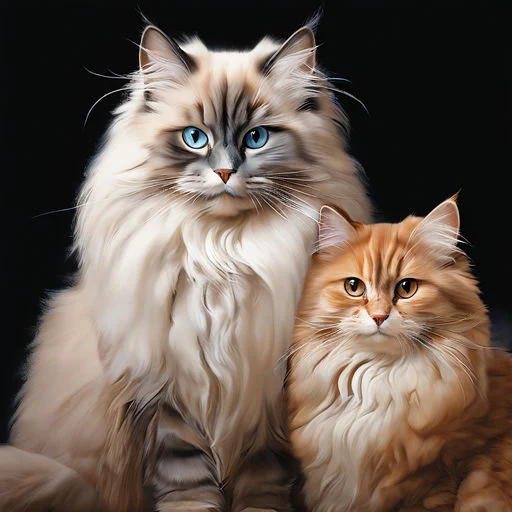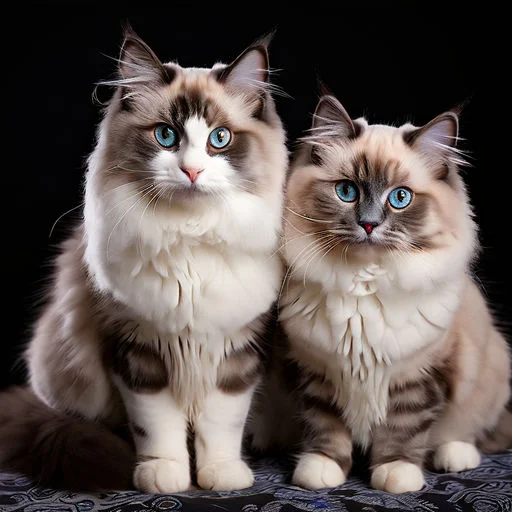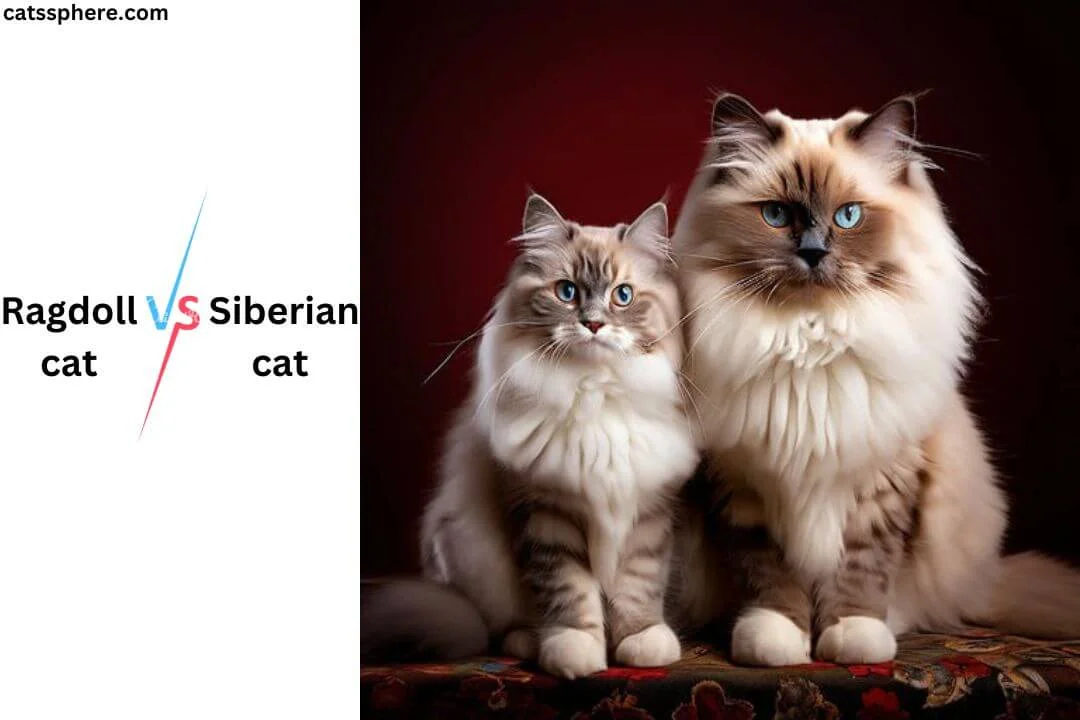Choosing the right cat breed can be a daunting task, especially when comparing two remarkable breeds like the Ragdoll vs Siberian Cat. Both breeds have unique characteristics that can significantly impact your decision. Let’s dive deep into the details and see which one might be the perfect fit for you.
Origins and History
History of Ragdoll Cats
The Ragdoll breed was developed in the 1960s by Ann Baker, a breeder from California. Known for their striking blue eyes and silky coats, Ragdolls were selectively bred for their docile and affectionate nature. The breed’s name, “Ragdoll,” comes from their tendency to go limp and relaxed when picked up, much like a ragdoll.
History of Siberian Cats
Siberian cats have a long and storied history, originating in the forests of Russia. These cats are considered a national treasure in their homeland and have been around for centuries, adapting to the harsh Siberian climate. Siberians were first introduced to the international cat fancy in the late 1980s and quickly gained popularity for their robust health and charming personalities.
Physical Characteristics

Size and Weight Comparison
Ragdolls are one of the larger cat breeds, with males typically weighing between 15-20 pounds and females weighing around 10-15 pounds. They have a muscular build and a semi-longhaired coat.
Siberians are also a large breed, with males weighing between 15-20 pounds and females weighing around 10-15 pounds. They have a sturdy, well-built frame and a dense, water-repellent coat.
Coat and Color Variations
Ragdolls have a plush, silky coat that comes in several color patterns, including colorpoint, mitted, and bicolor. Common colors include seal, blue, chocolate, and lilac.
Siberians boast a thick, triple-layered coat that comes in a wide variety of colors and patterns, including tabby, solid, and colorpoint. Their coat is designed to protect them from extreme cold.
Eye Color Differences
Ragdolls are renowned for their vivid blue eyes, which are a breed standard. The intensity of the blue can vary, but all Ragdolls have blue eyes.
Siberians can have a range of eye colors, including green, gold, blue, and copper. Blue-eyed Siberians are often found in colorpoint varieties.
Temperament and Personality
Ragdoll Personality Traits
Ragdolls are famous for their laid-back and affectionate nature. They are often described as “puppy-like” because they enjoy following their owners around and even playing fetch. Ragdolls are highly social and thrive on human interaction, making them excellent companions.
Siberian Personality Traits
Siberians are equally affectionate but tend to be a bit more independent. They are known for their playful and energetic demeanor, often engaging in vigorous play sessions. Despite their independence, Siberians are very loyal and form strong bonds with their families.
Activity Levels and Playfulness
Ragdolls are relatively calm and enjoy lounging around the house. They do have playful moments but generally prefer a relaxed environment.
Siberians, on the other hand, are quite active and love to climb, jump, and explore their surroundings. They require plenty of stimulation to keep them entertained.
Grooming and Maintenance

Ragdoll Grooming Needs
Ragdolls have a semi-longhaired coat that is relatively low-maintenance. Regular brushing once or twice a week helps to prevent matting and reduces shedding.
Siberian Grooming Needs
Siberians have a thick, triple-layered coat that requires more frequent grooming, especially during shedding seasons. Brushing several times a week is recommended to keep their coat in good condition.
Shedding Comparison
Both breeds shed, but Siberians tend to shed more heavily due to their dense undercoat. Regular grooming can help manage shedding for both breeds.
Health and Lifespan
Common Health Issues in Ragdolls
Ragdolls are generally healthy but can be prone to certain genetic conditions such as hypertrophic cardiomyopathy (HCM) and polycystic kidney disease (PKD). Regular veterinary check-ups are essential to catch any health issues early.
Common Health Issues in Siberians
Siberians are also a robust and healthy breed, but they can suffer from genetic conditions like hypertrophic cardiomyopathy (HCM). However, they are less prone to genetic diseases compared to some other breeds.
Lifespan Expectations
Ragdolls typically live between 12-15 years, though some can live even longer with proper care.
Siberians have a similar lifespan, averaging around 12-15 years. Their robust health contributes to their longevity.
Ragdoll vs Siberian Cat: A Comprehensive Comparison
Do Ragdoll Cats Like Water? Myth vs. Reality
Living Environment
Ideal Home Settings for Ragdolls
Ragdolls are well-suited for indoor living and prefer a calm, quiet environment. They enjoy lounging on soft surfaces and being close to their human companions.
Ideal Home Settings for Siberians
Siberians are adaptable and can thrive in various living environments, from apartments to larger homes. They appreciate having space to climb and explore, making cat trees and interactive toys a good investment.
Compatibility with Children and Other Pets

Both Ragdolls and Siberians are known for their gentle and friendly nature, making them excellent choices for families with children. They typically get along well with other pets, including dogs.
Diet and Nutrition
Nutritional Needs of Ragdolls
Ragdolls require a balanced diet rich in protein to support their muscle mass. High-quality commercial cat food or a carefully planned homemade diet can meet their nutritional needs.
Nutritional Needs of Siberians
Siberians also need a protein-rich diet to maintain their energy levels and support their muscular build. They thrive on high-quality commercial cat food or a balanced homemade diet.
Feeding Tips and Recommendations
Both breeds should have access to fresh water at all times and should be fed portion-controlled meals to prevent obesity. Consult your veterinarian for specific dietary recommendations based on your cat’s age, weight, and health status.
Training and Intelligence
Trainability of Ragdolls
Ragdolls are intelligent and can be trained to perform simple tricks and commands. They respond well to positive reinforcement and enjoy interactive play sessions.
Trainability of Siberians
Siberians are highly intelligent and can be trained to perform a variety of tricks and commands. Their playful nature makes training sessions fun and engaging.
Intelligence Comparison
Both breeds are intelligent, but Siberians may have a slight edge in terms of problem-solving abilities and agility. However, Ragdolls’ eagerness to please makes them equally enjoyable to train.
Cost and Availability
Cost of Purchasing a Ragdoll
Ragdolls are generally more expensive, with prices ranging from $800 to $2,500 depending on the breeder, pedigree, and location.
Cost of Purchasing a Siberian
Siberians can also be costly, with prices typically ranging from $1,000 to $2,000. The price varies based on factors such as breeder reputation, pedigree, and coat color.
Availability and Breeders
Both breeds have reputable breeders, but it’s essential to do thorough research to ensure you’re purchasing from a responsible breeder. Adoption options are also available for both breeds through rescue organizations.
Suitability as Pets
Who Should Get a Ragdoll?
Ragdolls are ideal for individuals or families seeking a calm, affectionate companion who enjoys lounging and cuddling. They are perfect for people who prefer a more relaxed pet that enjoys human company.
Who Should Get a Siberian?
Siberians are suitable for active households that can provide plenty of playtime and mental stimulation. They are great for families who enjoy interactive play and want a cat that is both affectionate and independent.
Lifestyle Compatibility
Consider your lifestyle and household dynamics when choosing between a Ragdoll and a Siberian. Both breeds can adapt to various environments, but their differing activity levels and grooming needs may sway your decision.
Adoption and Rescue
Adopting a Ragdoll
Ragdoll rescue organizations and shelters often have cats available for adoption. This can be a more affordable and rewarding option compared to purchasing from a breeder.
Adopting a Siberian
Siberian cats can also be found through rescue organizations and shelters. Adopting a Siberian can save a life and provide you with a loving companion.
Rescue Organizations and Resources
Research local and national rescue organizations for both Ragdolls and Siberians. Many organizations have websites and social media pages where they post available cats for adoption.
Breeding Considerations
Breeding Ragdolls
Breeding Ragdolls requires careful planning and knowledge of genetic health issues. Responsible breeders prioritize the health and well-being of their cats over profit.
Breeding Siberians
Breeding Siberians also demands a deep understanding of genetics and health concerns. Ethical breeders ensure their cats are healthy and well-cared for, contributing to the breed’s overall health.
Ethical Considerations
Always choose breeders who follow ethical breeding practices, provide proper care, and prioritize the health of their cats. Avoid breeders who engage in unethical practices or prioritize profit over animal welfare.
Conclusion: Ragdoll vs Siberian Cat

In the end, both Ragdolls and Siberians are wonderful breeds with unique qualities. Your choice will depend on your lifestyle, preferences, and what you’re looking for in a feline companion. Ragdolls offer a more laid-back and affectionate experience, while Siberians provide a playful and energetic addition to your household. Whichever breed you choose, you’ll be gaining a loyal and loving friend.
Unique FAQs After Conclusion
How do Ragdolls and Siberians handle being left alone? Ragdolls generally prefer constant companionship and may not do well being left alone for long periods. Siberians are more independent and can handle being alone better, though they still appreciate interaction.
Are Ragdolls or Siberians better for people with allergies? Siberians are known to produce fewer allergens compared to other breeds, making them a better choice for people with mild cat allergies. Ragdolls are not hypoallergenic.
What are the exercise needs of Ragdolls and Siberians? Ragdolls have moderate exercise needs and enjoy interactive play but are generally more sedentary. Siberians are very active and require more physical and mental stimulation to stay happy and healthy.
Do Ragdolls or Siberians get along better with dogs? Both breeds can get along well with dogs if properly introduced. However, Ragdolls’ laid-back nature might make them slightly more tolerant of canine companions.
Which breed is more suitable for apartment living? Both breeds can adapt to apartment living, but Ragdolls’ lower activity levels make them particularly well-suited for smaller spaces. Siberians may require more vertical space and enrichment to stay content in an apartment.

